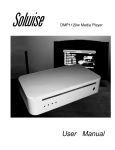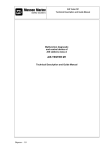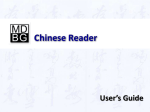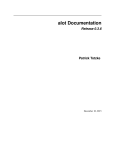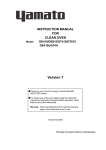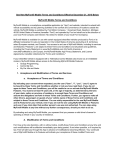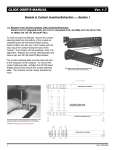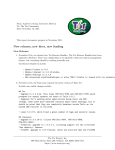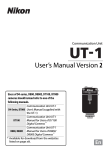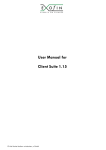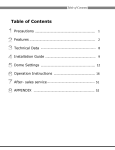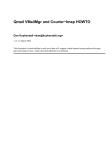Download Jaro Mail 3.2 - Document Root
Transcript
Jaro Mail 4
by Jaromil @ dyne.org
November 2015
Contents
1 Introduction
1.1 Features . . . . . . . . . . . . . . . . . . . . . . . . . . . . . . . . . . . . . . . . . . . . . . . .
1.2 Vision . . . . . . . . . . . . . . . . . . . . . . . . . . . . . . . . . . . . . . . . . . . . . . . . .
3
3
4
2 Diagram
5
3 Setup
3.1 Build . . . . . . . .
3.1.1 GNU/Linux
3.1.2 Apple/OSX
3.2 Install . . . . . . .
.
.
.
.
6
6
6
6
6
4 Configuration
4.1 Send and receive mail . . . . . . . . . . . . . . . . . . . . . . . . . . . . . . . . . . . . . . . .
4.2 Filter mail . . . . . . . . . . . . . . . . . . . . . . . . . . . . . . . . . . . . . . . . . . . . . . .
7
7
7
5 Organization
5.1 Folders . . . . .
5.2 Whitelist . . .
5.3 Blacklist . . . .
5.4 Organization In
.
.
.
.
.
.
.
.
.
.
.
.
.
.
.
.
.
.
.
.
.
.
.
.
.
.
.
.
.
.
.
.
.
.
.
.
.
.
.
.
.
.
.
.
.
.
.
.
.
.
.
.
.
.
.
.
.
.
.
.
.
.
.
.
.
.
.
.
.
.
.
.
.
.
.
.
.
.
.
.
.
.
.
.
.
.
.
.
.
.
.
.
.
.
.
.
.
.
.
.
.
.
.
.
.
.
.
.
.
.
.
.
.
.
.
.
.
.
.
.
.
.
.
.
.
.
.
.
.
.
.
.
.
.
.
.
.
.
.
.
.
.
.
.
.
.
.
.
.
.
.
.
.
.
.
.
.
.
.
.
.
.
.
.
.
.
.
.
.
.
.
.
.
.
.
.
.
.
.
.
.
.
.
.
.
.
.
.
.
.
.
.
.
.
.
.
.
.
.
.
.
.
.
.
.
.
.
.
.
.
.
.
.
.
.
.
.
.
.
.
.
.
.
.
.
.
.
.
.
.
.
.
.
.
.
.
.
.
.
.
.
.
.
.
.
.
.
.
.
.
.
.
.
.
.
.
.
.
.
.
.
.
.
.
.
.
.
.
.
.
.
.
.
.
.
.
.
.
.
.
.
.
.
.
8
8
8
9
9
6 Workflow
6.1 Fetch and read your mail at home . . . .
6.2 Write a new mail . . . . . . . . . . . . . .
6.3 Write a new email from the commandline
6.4 Reply messages . . . . . . . . . . . . . . .
6.5 Peek without downloading anything . . .
6.6 Save important emails for later . . . . . .
6.7 Workflow in brief . . . . . . . . . . . . . .
.
.
.
.
.
.
.
.
.
.
.
.
.
.
.
.
.
.
.
.
.
.
.
.
.
.
.
.
.
.
.
.
.
.
.
.
.
.
.
.
.
.
.
.
.
.
.
.
.
.
.
.
.
.
.
.
.
.
.
.
.
.
.
.
.
.
.
.
.
.
.
.
.
.
.
.
.
.
.
.
.
.
.
.
.
.
.
.
.
.
.
.
.
.
.
.
.
.
.
.
.
.
.
.
.
.
.
.
.
.
.
.
.
.
.
.
.
.
.
.
.
.
.
.
.
.
.
.
.
.
.
.
.
.
.
.
.
.
.
.
.
.
.
.
.
.
.
.
.
.
.
.
.
.
.
.
.
.
.
.
.
.
.
.
.
.
.
.
.
.
.
.
.
.
.
.
.
.
.
.
.
.
.
.
.
.
.
.
.
.
.
.
.
.
.
.
.
.
.
.
.
.
.
9
9
10
10
11
11
11
12
7 Searching
7.1 Combining terms . . . . . . .
7.2 Search terms . . . . . . . . .
7.3 Date and time search . . . . .
7.3.1 The range expression .
7.3.2 Relative date and time
7.3.3 Absolute time formats
.
.
.
.
.
.
.
.
.
.
.
.
.
.
.
.
.
.
.
.
.
.
.
.
.
.
.
.
.
.
.
.
.
.
.
.
.
.
.
.
.
.
.
.
.
.
.
.
.
.
.
.
.
.
.
.
.
.
.
.
.
.
.
.
.
.
.
.
.
.
.
.
.
.
.
.
.
.
.
.
.
.
.
.
.
.
.
.
.
.
.
.
.
.
.
.
.
.
.
.
.
.
.
.
.
.
.
.
.
.
.
.
.
.
.
.
.
.
.
.
.
.
.
.
.
.
.
.
.
.
.
.
.
.
.
.
.
.
.
.
.
.
.
.
.
.
.
.
.
.
.
.
.
.
.
.
.
.
.
.
.
.
.
.
.
.
.
.
.
.
.
.
.
.
12
13
13
14
14
14
15
. . . .
. . . .
. . . .
Brief .
.
.
.
.
.
.
.
.
.
.
.
.
.
.
.
.
.
.
.
.
.
.
.
.
.
.
.
.
.
.
.
.
.
.
.
.
.
.
.
.
.
.
.
.
.
.
.
.
.
.
.
.
.
.
.
.
.
.
.
.
.
.
.
.
.
.
.
.
.
.
.
.
.
.
.
.
.
.
.
.
.
.
1
JaroMail manual
7.3.4
7.3.5
version 4
Absolute date formats . . . . . . . . . . . . . . . . . . . . . . . . . . . . . . . . . . . .
Time zones . . . . . . . . . . . . . . . . . . . . . . . . . . . . . . . . . . . . . . . . . .
15
16
8 Compute and visualize statistics
16
8.1 Statistics in brief . . . . . . . . . . . . . . . . . . . . . . . . . . . . . . . . . . . . . . . . . . . 16
9 Addressbook
17
9.1 Address lists . . . . . . . . . . . . . . . . . . . . . . . . . . . . . . . . . . . . . . . . . . . . . . 17
9.2 Export to VCard and other formats . . . . . . . . . . . . . . . . . . . . . . . . . . . . . . . . 18
9.3 Addressbook in brief . . . . . . . . . . . . . . . . . . . . . . . . . . . . . . . . . . . . . . . . . 18
10 Storage and backup
10.1 Merge maildirs .
10.2 Backup mails . .
10.3 Filter a maildir .
10.4 Storage in brief .
.
.
.
.
.
.
.
.
.
.
.
.
.
.
.
.
.
.
.
.
.
.
.
.
.
.
.
.
.
.
.
.
.
.
.
.
.
.
.
.
.
.
.
.
.
.
.
.
.
.
.
.
.
.
.
.
.
.
.
.
.
.
.
.
.
.
.
.
.
.
.
.
.
.
.
.
.
.
.
.
.
.
.
.
.
.
.
.
.
.
.
.
.
.
.
.
.
.
.
.
.
.
.
.
.
.
.
.
.
.
.
.
.
.
.
.
.
.
.
.
.
.
.
.
.
.
.
.
.
.
.
.
.
.
.
.
.
.
.
.
.
.
.
.
.
.
.
.
.
.
.
.
.
.
.
.
.
.
.
.
.
.
.
.
.
.
.
.
.
.
.
.
19
19
19
20
20
11 Security
20
11.1 Password storage . . . . . . . . . . . . . . . . . . . . . . . . . . . . . . . . . . . . . . . . . . . 20
11.2 A tip for GNU/Linux users . . . . . . . . . . . . . . . . . . . . . . . . . . . . . . . . . . . . . 21
12 Advanced usage
12.1 Replay: avoid repeating long operations . .
12.2 Send anonymous emails . . . . . . . . . . .
12.3 Zsh commandline completion . . . . . . . .
12.4 Quickly send a file via email on Apple/OSX
.
.
.
.
.
.
.
.
.
.
.
.
.
.
.
.
.
.
.
.
.
.
.
.
.
.
.
.
.
.
.
.
.
.
.
.
.
.
.
.
.
.
.
.
.
.
.
.
.
.
.
.
.
.
.
.
.
.
.
.
.
.
.
.
.
.
.
.
.
.
.
.
.
.
.
.
.
.
.
.
.
.
.
.
.
.
.
.
.
.
.
.
.
.
.
.
.
.
.
.
.
.
.
.
.
.
.
.
.
.
.
.
21
21
22
22
23
13 Acknowledgements
13.1 License . . . . . . .
13.2 Jaro Mail credits .
13.3 Mutt credits . . . .
13.4 Notmuch credits .
13.5 Fetchmail credits .
13.6 MSmtp credits . .
13.7 Statistics modules
.
.
.
.
.
.
.
.
.
.
.
.
.
.
.
.
.
.
.
.
.
.
.
.
.
.
.
.
.
.
.
.
.
.
.
.
.
.
.
.
.
.
.
.
.
.
.
.
.
.
.
.
.
.
.
.
.
.
.
.
.
.
.
.
.
.
.
.
.
.
.
.
.
.
.
.
.
.
.
.
.
.
.
.
.
.
.
.
.
.
.
.
.
.
.
.
.
.
.
.
.
.
.
.
.
.
.
.
.
.
.
.
.
.
.
.
.
.
.
.
.
.
.
.
.
.
.
.
.
.
.
.
.
.
.
.
.
.
.
.
.
.
.
.
.
.
.
.
.
.
.
.
.
.
.
.
.
.
.
.
.
.
.
.
.
.
.
.
.
.
.
.
.
.
.
.
.
.
.
.
.
.
.
.
.
.
.
.
.
.
.
.
.
.
.
.
23
23
24
24
24
25
25
25
.
.
.
.
.
.
.
.
.
.
.
.
.
.
.
.
.
.
.
.
.
.
.
.
.
.
.
.
.
.
.
.
.
.
.
.
.
.
.
.
.
.
.
.
.
.
.
.
.
.
.
.
.
.
.
.
.
.
.
.
.
.
.
.
.
.
.
.
.
.
.
.
.
.
.
.
.
.
.
.
.
.
.
.
.
.
.
.
.
.
.
.
.
.
.
.
.
.
14 Appendix
26
14.1 Configuration examples . . . . . . . . . . . . . . . . . . . . . . . . . . . . . . . . . . . . . . . 26
14.1.1 Accounts/default.txt . . . . . . . . . . . . . . . . . . . . . . . . . . . . . . . . . . . . . 26
14.1.2 Filters.txt . . . . . . . . . . . . . . . . . . . . . . . . . . . . . . . . . . . . . . . . . . . 27
Free Software Manual
–2–
Dyne.org Foundation
JaroMail manual
1
version 4
Introduction
Jaro Mail is an integrated suite of interoperable tools to manage e-mail communication in a private and
efficient way, without relying too much on on-line services, in fact encouraging users to store their email
locally.
Rather than reinventing the wheel, this suite reuses existing free and open source tools and protocols and is
mainly targeted for GNU/Linux/BSD desktop usage.
This manual illustrates the usage of Jaro Mail. The newest version of this manual is made available on
http://files.dyne.org/jaromail/jaromail-manual.pdf
1.1
Features
• Minimalistic and efficient interface with message threading
• Targets intensive usage of e-mails and mailinglists
• Stores e-mails locally in a reliable format (maildir)
• Integrates whitelisting and blacklisting, local and remote
• Can do search and backup by advanced expressions
• Automatically generates filter rules (sieve)
• Imports and exports VCard contacts to addressbook
• Computes and shows statistics on mail traffic
• Facilitates sending anonymous emails (Mixmaster)
• Encrypted password storage using OS native keyrings
• Advanced maildir tools (merge, backup, address extraction)
• Defers connections for off-line operations
• Checks SSL/TLS certificates when fetching and sending mails
Free Software Manual
–3–
Dyne.org Foundation
JaroMail manual
version 4
• Supports strong encryption messaging (GnuPG)
• Multi platform: GNU/Linux/BSD, Apple/OSX
• Old school, used by its author for the past 10 years
1.2
Vision
The internet offers plenty of free services, on the
wave of the Web2.0 fuzz and the community boom,
while all private informations are hosted on servers
owned by global corporations and monopolies.
It is important to keep in mind that no-one else better than you can ensure the privacy of your personal
data. Server hosted services and web integrated
technologies gather all data into huge information
pools that are made available to established economical and cultural regimes.
The vision behind this software is that of sharing
a simple and consistent way to operate e-mail communication with tools that are available on most
platforms and can be as well used remotely over a
secure shell connection.
Jaro Mail aims to facilitate the task of downloading
and storing e-mail archives off-line in a way that
they can be still accessible in more than 10 years time and independently of any software. Nowadays many
users have the habit of keeping all their e-mails on servers, accessing them through an often clumsy web
interface, while downloading them can free space and improve their privacy.
Free Software Manual
–4–
Dyne.org Foundation
JaroMail manual
2
version 4
Diagram
A little diagram that clarifies a bit where do we place the components and actions involved in managing
one’s email communication:
Acronym
MUA
MTA
LDA
MDA
SMTP
ANON
GPG
STORE
Free Software Manual
Function
Mail User Agent
Mail Transport Agent
Local Delivery Agent
Remote Delivery Agent
Mail delivery agent
Anonymous delivery
Search engine
Addressbook
Cryptographic Agent
Cryptographic Storage
–5–
Software
Mutt
Fetchmail
Jaro Mail
Sieve
MSmtp
MixMaster
Notmuch
ABook
GnuPG
Tomb
Dyne.org Foundation
JaroMail manual
3
version 4
Setup
3.1
Build
Jaro Mail needs to be built on GNU/Linux systems.
For Apple/OSX users it comes in a pre-compiled bundle.
3.1.1
GNU/Linux
Some dependencies are needed in order to build this software. The Makefile for GNU/Linux configures the
build environment automatically on Debian and Fedora systems, using their packaging to install all needed
packages.
The dependencies to be installed on the system for JaroMail are
• to build: gcc bison flex make autoconf automake sqlite3 libglib2.0-dev libgnome-keyring-dev
• to run: fetchmail msmtp mutt pinentry abook wipe notmuch alot
To install all needed components (done automatically, requires root):
make
Once compiled then make install will put all JaroMail files in /usr/local/share/jaromail.
3.1.2
Apple/OSX
Apple/OSX users that have no experience in building software can obtain a pre-built universal binary from
our download zone on http://files.dyne.org/jaromail/binary
One can simply drag JaroMail into Applications. When started JaroMail opens a Terminal window preconfigured with its environment, to activate it for any terminal add this to ‘~/.profile‘:
export PATH=/Applications/JaroMail.app/Contents/Resources/jaro/bin:$PATH
3.2
Install
Installing Jaro Mail once all dependencies are build is fairly easy: make a directory where all the emails and
settings needs to be, change to the directory and init the environment:
mkdir $HOME/Mail
cd $HOME/Mail
jaro init
Every installation of Jaro Mail is fully reentrant, meaning the directory where it gets initialised contains all
maildirs, configurations, filters, whitelist, addressbooks and other necessary files.
A single user can have multiple Jaro Mail installations to permit the complete separation of E-Mail identities.
If called from outside the installation directory, the jaro command will use the environmental variable
$JAROMAILDIR to find out the active installation being in use. If one is using a different installation
path then should first change that, i.e:
export JAROMAILDIR=$HOME/OtherIdentities/Luther/Mail
Free Software Manual
–6–
Dyne.org Foundation
JaroMail manual
4
version 4
Configuration
The place where Jaro Mail is installed ($HOME/Mail by default) contains all configuration files.
For Apple/OSX users, this directory is inside their $HOME/Library, then Application Support and
then JaroMail.
From now own, we will call this place the Mail directory.
Inside the Mail directory are all needed configurations to operate JaroMail. Such configurations are in
readable plain text files that can be edited using any editor. Inside them there are comments to explain the
settings: all comment lines start by ’#’ and will be ignored by JaroMail.
The most important files to start configuring are:
• Identity.txt : set up the way your email identity appear to others
• Accounts/default.txt : main account configuration (there can be more)
• Aliases.txt : more email addresses one may receive on the configured accounts
• Filters.txt : Full set of mailinglist sorting rules
• Applications.txt : mime type associations to programs used to open attachments
• Mutt.txt : mutt specific custom configurations
4.1
Send and receive mail
Inside the Mail directory is found the folder Accounts with brief instructions and default templates to
fill with Imap and Smtp account configurations to fetch mail. A default template will be found in fresh
installations: Accounts/default.txt. The configuration can be edited with one’s favourite text editor, the
format of the file is pretty self-explanatory.
It is possible to have more than one account (simply as a new file in the Accounts/ directory) and in fact
when retreiving e-mails using the jaro fetch command all accounts will be processed, unless one is explicitly
selected using the -a commandline option.
The file Identity.txt is also found in the Mail directory and it contains basic settings on the published
user identity (From: field) and any other Mutt specific configuration directives, such as custom headers
appearing in composed e-mails and the default GPG1 key to be used when signing and encrypting them.
For more information about the vast amount of configurations that are supported please refer to the Mutt
documentation2
4.2
Filter mail
In the mail directory a file named Filters.txt can be created and filled in with rules referencing the contents
of the From: or To: fields of each e-mail that is fetched. The mails matching will be then saved in the
indicated maildirs (created if not existing) to keep a bit of order, especially useful for mailinglist users.
The format of the filters configurarion is pretty easy and self explanatory, an example is found in the appendix
of this manual.
1 GPG stands for GNU Privacy Guard, a system to securely encrypt and decrypt messages and files so that noone can read
their content, even when intercepting the communication.
2 The Mutt configuration manual is found on http://www.mutt.org/doc/manual or simply typing ’man mutt’ in a console
terminal.
Free Software Manual
–7–
Dyne.org Foundation
JaroMail manual
5
version 4
Organization
One of the main goals for Jaro Mail is to organize the e-mail workflow so that one’s attention is dedicated to
important communications, rather than being constantly distracted by various degrees of spam and the need
to weed it out of the mailbox. This ambitious task is pursued by realizing an integrated approach consisting
of flexible whitelisting and the distinction between mails from known people and the rest.
5.1
Folders
First lets start with a categorization of the standard maildirs and a brief description for each. This information is very important to understand how Jaro Mail works: these maildirs are standard in Jaro Mail,
here they are listed in order of priority
Folder
known
priv
unsorted
unsorted.ml
zz.blacklist
zz.spam
zz.bounces
What goes in there
Mails whose sender is known (Whitelist)
Unknown sender, we are among explicit recipients
Unknown sender, we are not among recipients
From a mailinglist that we haven’t filtered yet
Mails whose sender is not desired (Blacklist)
Mails that are tagged as spam (server-side)
Mail bounces like mailman and similar
The advantage using such a folder organization is that every time we open up the mail reader we will be
presented with something we are likely to be most interested in (known people replying our mails) and
progressively, as we will have the time to scroll through, mails from "new people" or mass mailings of sort.
This setup is handy especially considering it produces sieve filters that can be uploaded to mail servers and
processed server-side. Imagine having your email on a fixed computer, but occasionally checking it from a
mobile phone: server-side filtering will save you time by presenting a clean INBOX of whitelisted contacts
for the mobile phone use.
Please note this organization does not includes spam, which is supposedly weeded out on the server via
spamlists: White/Blacklisting has more to do with our own selection of content sources than with the
generic protection from random pieces of information.
At last, anything that is matched by filters configured in Filters.txt will be saved into the named maildir,
whose name can be freely choosen.
5.2
Whitelist
The way whitelisting works if quite crucial to this setup and, at the same time, is fairly simple since it does
not include any automatic detection, learning filters, Markov chains or Bayesian A/I. We believe the user
should be in full control of prioritizing communication channels and at the same time constantly able to
tweak the setup in an easy way.
To whitelist an address is sufficient to send it an e-mail: at the moment the message is sent Jaro Mail will
remember the destination address and prioritize all messages coming back from it. This we call implicit
whitelisting.
To explicitly whitelist an address from inside the mail reader index press [ a ] while selecting an email, this
will add in the whitelist the sender address (From: header). If you want to add all addresses reached by the
mail (From: To: and Cc: fields) use the same letter capitalized pressing shift [ A ].
Free Software Manual
–8–
Dyne.org Foundation
JaroMail manual
version 4
All addresses selected this way will have the privilege of ending up in your known/ folder, plus their
name and e-mail will be completed automatically when composing a new email, pressing the Tab key while
indicating them among the recipients.
5.3
Blacklist
To blacklist an address instead one can use the [ z ] key while an e-mail is selected on the index: the sender
indicated in the From: field will be downgraded to the very bottom of your priorities, closes to spam than
the rest, the most infamous zz.blacklist/ folder.
5.4
Organization In Brief
Below a recapitulation of keys related to the white and blacklisting functionality, to be used in the e-mail
index or when an e-mail is open inside the mail user agent:
List
White
White
Black
Black
6
Key
a
A (shift)
z
Z (shift)
Function
Add the sender address
Add all addresses
Blacklist the sender
Blacklist all addresses
Fields
From:
From: To: Cc:
From:
From: To: Cc:
Workflow
This section goes through a scenario of simple usage for Jaro Mail
6.1
Fetch and read your mail at home
As you acces your computer where Jaro Mail has been configured, you can open a Terminal and type:
jaro fetch
This will download all new mails.
If you have configured fetchall among the imap account options, then will delete them from the server,
freeing online space.
If you have configured the keep option, which is the default, Jaro Mail will only download the email that
you have not yet read and in any case it won’t delete anything from the server. Remove the keep option to
delete on the server all emails that are downloaded.
jaro
This will launch mutt on the first folder containing unread emails, starting from the known folder, then
priv, then all the destinations specified by Filters.txt exactly in the ascending order they are listed in that
configuration file..
From there on, pressing = or c you can change to other folders and your unsorted and unsorted.ml mails.
Free Software Manual
–9–
Dyne.org Foundation
JaroMail manual
6.2
version 4
Write a new mail
If you like to write a mail to someone, hit m and write the recipient address, you will be then asked about
any additional Cc: recipients.
If you don’t remember the emails of the recipients, you can just type their name or parts of the email you
remember, then press the [ Tab ] key for completion. A list of addresses may popup with matches found in
your whitelist addressbook to help remind who are you looking for.
The email is composed using a special Vim configuration that facilitates justifying text to 72 columns using
[ ctrl-j ]. After composing the email you will be able to review it and change:
• the From: field using [ ESC f ]
• the recipient in the To: field using [ t ]
• the recipients in the Cc: field using [ c ]
• the subject string using [ s ]
You’ll also be able to add more attachments by pressing a and use the arrow keys to move over the existing
ones and delete them using [ D ] (please note that is a uppercase D, because lowercase d will just add a
description for the attachment).
At last, when ready, pressing y will queue the email into the outbox, ready for sending.
One can review at any time the sending queue, which is just another maildir named outbox
jaro outbox
Mails can be deleted from this view using [ d ] or edited using [ e ] which will allow tweaking of both the
header and body of the email.
Once sure the outbox contains all what needs to be sent, make sure the computer is connected to the Internet
and issue the send command:
jaro send
Jaro Mail will send all emails in outbox, one by one, listing their recipients and size while doing so. If
successful, mails will be removed from the outbox and put into the sent folder, which can be accessed from
inside mutt or with the command jaro open sent.
6.3
Write a new email from the commandline
Jaro Mail supports a lot of commandline operations based on stdin/stdout pipes, which makes it pretty easy
to use in scripts that send emails and attachments.
If you have written a plain-text email using your favorite editor, you can send it quickly using the commandline: save the email into a txt file and then pipe it into jaro compose followed by a list of recipients and,
optionally a list of filenames to attach. For example:
cat Greetings.txt | jaro compose friends@dyne.org picture01.jpg jingle02.mp3 ~/myicons/*
The command above may send an email with various separate attachments (using MIME encapsulation): a
picture, an hopefully small audio file and a list of icons which are all the files contained into the myicons/
directory. In this case the recipient will be friends@dyne.org, but may be any other email address found on
the commandline in any position.
Once executed you will find this email in jaro outbox, ready to be reviewed and sent with jaro send.
Free Software Manual
– 10 –
Dyne.org Foundation
JaroMail manual
6.4
version 4
Reply messages
While browsing through the index of emails in various folders, one can reply any of them just by pressing
the [ r ] key, which will ask if the original message should be quoted and then open your favorite editor to
compose your text.
If the email you are replying has been sent to multiple recipients (for instance using multiple addresses in
the Cc: or From: fields) they will all be included, but you will have the possibility to exclude them by hand,
editing the Cc: field. To remove them all at once use [ ctrl-k ] just like deliting a line on the terminal.
It is also possible to forward a message to someone else than the sender, for instance to submit it to his or
her attention, or that of a mailinglist. To do that, you can use the [ f ] key which will present you with the
full message and the possibility to write something on top of it, to describe its contents to its new recipients.
Forwards include all attachments and are sent as attachments themselves, but this behavious can be changed
as a confirmation to "send forward as attach" is asked.
6.5
Peek without downloading anything
If you are around and like to see your new mails without downloading them, then you can use the peek
function:
jaro peek
This will open the default configured IMAP account and folder over SSL protocol (securing the data transfer)
and allow you to browse, read and reply your emails without downloading them.
Using peek you can reply and even delete emails, but be careful since what you delete here will be removed
from the server and won’t be there when you download it from home.
This functionality can be also very useful if you are from a slow connection and need to delete some email
that is clogging it and that you are not able to download because of its size.
The peek command will automatically open the INBOX, but also other remote imap folders can be specified,
like for instance priv or unsorted if whitelisting is also setup server-side (the sieve filters generated by Jaro
Mail need to be uploaded on the server). To have a list of imap folders on the server a command is also
available:
jaro imap listfolders
Will list on the terminal all folders found on the imap account, one per line.
6.6
Save important emails for later
Sometimes one can be on the rush while reading emails (local or via imap) and flagging them as important
can be useful to keep focus on priorities. In some cases it is very useful to save such important messages
locally for later reference, for instance in a folder keeping messages that need to be remembered and that
will constitute a kind of TODO list (a’la GTD).
Jaro Mail implements such functionalities: by pressing the [ F ] key (uppercase) one can flag an email,
which will turn bright-green in the index. In addition to that there is a folder called remember/ where
one can copy emails on the fly using the [ R ] key (uppercase) any time. Messages will be duplicated into
the remember folder (which of course can be opened with the command jaro remember) so they can also
be edited with annotations on the task they refer to, for instance using the [ e ] key, without affecting the
original message.
Free Software Manual
– 11 –
Dyne.org Foundation
JaroMail manual
6.7
version 4
Workflow in brief
Below a recapitulation of keys commonly used in our workflow
Key
m
Tab
r
d
y
f
=
c
F
R
s
C
7
Function
Compose a new message
Complete addresses and folders input
Reply to the sender of a message
Delete a message
Send a message (queue in outbox)
Forward a message to new recipients
List all filtered maildir folders
Change to another folder
Flag a message as important
Copy a message to remember
Move a message to another folder
Copy a message to another folder
Searching
Searching across all your emails it is as important as demanding of a task. Jaro Mail implements it using
Notmuch which is relying on the Xapian search engine, completely relying on local computations made on
your machine, there is no data at all being communicated on-line.
To index and tag all your emails that are locally archived in Jaro Mail use:
jaro index
This will take a while and increase the size of the storage of about one sixth of its total occupation, but
will definitely come useful when in need of searching rapidly across all available emails. To run a search for
emails containing the ’open source’ string, do
jaro search open source
To search for all emails containing this string and dated between now and the last two weeks, do
jaro search open source date:2w..
The search command prints out a list of found filenames which may be useful to a script, but less useful to
a human. In order to read a quick summary of the emails found it is possible to pipe the results into the
headers command which will print out date, sender and subject of each file
jaro search open source date:2w.. | jaro headers
Searching has also an interactive interface called alot which pops up to show search results and browse
through them, refine the terms and in general operate on emails with the usual keys. One can also reply to
emails directly from alot:
jaro alot search expression strings folder:known
To restrict the search to a single folder, one can use the folder: prefix to search terms. Tags can be used
also with tag: as well dates can be specified with ranges using date:. Consecutive string expressions are
aloud to refine the search match, connected with logical and/or, plus also the header to search can be
indicated, as for instance from: or to:. Read more about this below in the Search term and Date and
time search sections (extracts from the notmuch-search-terms manpage) and on the notmuch webpage at
http://notmuchmail.org
Free Software Manual
– 12 –
Dyne.org Foundation
JaroMail manual
version 4
With the addr command the search will be run on the whitelist addressbook entries instead of actual email
contents.
jaro addr joe
Will list all addresses matching the string ’joe’ inside the whitelist addressbook. Also the blacklist can be
searched this way adding the switch -l blacklist.
7.1
Combining terms
In addition to individual terms, multiple terms can be combined with Boolean operators ( and, or, not
, etc.). Each term in the query will be implicitly connected by a logical AND if no explicit operator is
provided.
Parentheses can also be used to control the combination of the Boolean operators, but will have to be
protected from interpretation by the shell, (such as by putting quotation marks around any parenthesized
expression).
7.2
Search terms
The search terms can consist of free-form text (and quoted phrases) which will match all messages that
contain all of the given terms/phrases in the body, the subject, or any of the sender or recipient headers.
As a special case, a search string consisting of exactly a single asterisk "*" will match all messages.
In addition to free text, the following prefixes can be used to force terms to match against specific portions
of an email, (where <brackets> indicate user-supplied values):
from:<name-or-address>
to:<name-or-address>
subject:<word-or-quoted-phrase>
attachment:<word>
tag:<tag> (or is:<tag>)
id:<message-id>
thread:<thread-id>
folder:<directory-path>
date:<since>..<until>
The from: prefix is used to match the name or address of the sender of an email message.
The to: prefix is used to match the names or addresses of any recipient of an email message, (whether To,
Cc, or Bcc).
Any term prefixed with subject: will match only text from the subject of an email. Searching for a phrase
in the subject is supported by including quotation marks around the phrase, immediately following subject:.
The attachment: prefix can be used to search for specific filenames (or extensions) of attachments to email
messages.
For tag: and is: valid tag values include inbox and unread by default for new messages added by notmuch
new as well as any other tag values added manually with notmuch tag.
For id:, message ID values are the literal contents of the Message-ID: header of email messages, but without
the ’<’, ’>’ delimiters.
Free Software Manual
– 13 –
Dyne.org Foundation
JaroMail manual
version 4
The thread: prefix can be used with the thread ID values that are generated internally by notmuch (and
do not appear in email messages). These thread ID values can be seen in the first column of output from
notmuch search
The folder: prefix can be used to search for email message files that are contained within particular directories
within the mail store. If the same email message has multiple message files associated with it, it’s sufficient
for a match that at least one of the files is contained within a matching directory. Only the directory
components below the top-level mail database path are available to be searched.
7.3
Date and time search
See DATE AND TIME SEARCH below for details on the range expression, and supported syntax for
<since> and <until> date and time expressions.
The date: prefix can be used to restrict the results to only messages within a particular time range (based
on the Date: header) with a range syntax of:
date:<since>..<until>
The syntax <initial-timestamp>..<final-timestamp> can be represented using the number of seconds since
1970-01-01 00:00:00 UTC.
The search syntax also understands a variety of standard and natural ways of expressing dates and times,
both in absolute terms ’2012-10-24 ’ and in relative terms ’yesterday’. Any number of relative terms can be
combined ’1 hour 25 minutes’ and an absolute date/time can be combined with relative terms to further
adjust it. A non-exhaustive description of the syntax supported for absolute and relative terms is given
below.
7.3.1
The range expression
date:<since>..<until>
The above expression restricts the results to only messages from <since> to <until>, based on the Date:
header.
<since> and <until> can describe imprecise times, such as "yesterday". In this case, <since> is taken as the
earliest time it could describe (the beginning of yesterday) and <until> is taken as the latest time it could
describe (the end of yesterday). Similarly, date:january..february matches from the beginning of January to
the end of February.
Currently, we do not support spaces in range expressions. You can replace the spaces with ’\_’, or (in most
cases) ’-’, or (in some cases) leave the spaces out altogether. Examples in this man page use spaces for
clarity.
Open-ended ranges are supported (since Xapian 1.2.1), i.e.
date:<since>.. to not limit the start or end time, respectively.
it’s possible to specify date:..<until> or
Entering date:expr without ".." (for example date:yesterday) won’t work, as it’s not interpreted as a range
expression at all. You can achieve the expected result by duplicating the expr both sides of ".." (for example
date:yesterday..yesterday).
7.3.2
Relative date and time
[N|number]
Free Software Manual
– 14 –
Dyne.org Foundation
JaroMail manual
version 4
(years|months|weeks|days|hours|hrs|minutes|mins|seconds|secs) [...]
All refer to past, can be repeated and will be accumulated.
Units can be abbreviated to any length, with the otherwise ambiguous single m being m for minutes and M
for months.
Number can also be written out one, two, . . . , ten, dozen, hundred. Additionally, the unit may be preceded
by "last" or "this" (e.g., "last week" or "this month").
When combined with absolute date and time, the relative date and time specification will be relative from
the specified absolute date and time.
Examples:
5M2d
two weeks
7.3.3
Absolute time formats
H[H]:MM[:SS]
[(am|a.m.|pm|p.m.)]
H[H] (am|a.m.|pm|p.m.)
HHMMSS
now
noon
midnight
Examples:
17:05
5pm
7.3.4
Absolute date formats
YYYY-MM[-DD]
DD-MM[-[YY]YY]
MM-YYYY
M[M]/D[D][/[YY]YY]
M[M]/YYYY
D[D].M[M][.[YY]YY]
D[D][(st|nd|rd|th)] Mon[thname] [YYYY]
Mon[thname] D[D][(st|nd|rd|th)] [YYYY]
Wee[kday]
Month names can be abbreviated at three or more characters.
Weekday names can be abbreviated at three or more characters.
Examples:
2012-07-31
31-07-2012
7/31/2012
Free Software Manual
– 15 –
Dyne.org Foundation
JaroMail manual
version 4
August 3
7.3.5
Time zones
(+|-)HH:MM
(+|-)HH[MM]
Some time zone codes.
Examples:
UTC
EET
8
Compute and visualize statistics
The stats command is useful to quickly visualize statistics regarding folder usage as well the frequency of
emails found in a stream from stdin. Such streams can be produced by the search and extract commands
for instance and passed to stats in order to have a more graphical (yet ASCII based) visualization of results.
For example lets visualize the frequency of email domain hosts in our whitelist:
jaro addr | jaro stat emails
Will print out bars and domains in descending order, highlighting the most frequent email domain in our
contacts, which turns out to be very often gmail.com, unfortunately for our own privacy.
To visualize the frequency of traffic across our filtered folders in the past month:
jaro search date:1w.. | jaro stat folders
Will show quantities of mails filed to folders during the past week, quickly highlighting the mailinglists that
have seen more recent activity.
To see who is most active in a mailinglist which is filtered to a folder:
jaro search folder:org.dyne.dng | jaro extract stdin from | jaro stat names
Will give an overview on who is the most prolific writer in the org.dyne.dng mailinglist, filed into the folder
by a rule in Filters.txt like:
to
dng@lists.dyne
save
org.dyne.dng
Please note the extract command is there to extract email addresses and names found in the From: field
of all search hits, the command is explained better in the next chapter: Addressbook.
8.1
Statistics in brief
All stats commands takes lists of addresses or email messages from stdin.
command
stats email
stats names
stats folders
Free Software Manual
effect
reads addresses from stdin, prints out stats on frequency of emails found
reads addresses from stdin, prints out stats on frequency of names found
reads paths to messages from stdin, prints out stats on frequency of folders
– 16 –
Dyne.org Foundation
JaroMail manual
version 4
So in case of stats email or stats names any result of search must be first filtered by extract in order to
provide addresses to stats, else errors will occur. To limit the stats to the From: field use the extract stdin
from also shown in examples, any other refinement can be done also in the domain of the search commands.
9
Addressbook
Addressbooks are the files storing the whitelist, the blacklist and optionally other custom lists of addresses.
The format we use is native abook database files, by convention in $JAROMAILDIR/whitelist.abook and
$JAROMAILDIR/blacklist.abook. More custom addressbooks can be used by specifying them using -l on
the commandline, for instance -l family will query the $JAROMAILDIR/family.abook addressbook; when
not used, whitelist is the default.
Addressbooks can be edited using a interactive console interface, for instance to add or delete entries by
hand: use the abook command and optionally the -l option.
jaro abook
This will open the current whitelist for edit. To edit the blacklist add -l blacklist instead.
To quickly dump to the console all names and addresses in the Jaro Mail addressbook, one can use the list
command
jaro list
To match a string across the addressbook, simply use the composite command addr followed by strings, for
instance:
jaro addr dyne
will list all addresses containing ’dyne’ in your whitelist.
9.1
Address lists
Jaro Mail handles lists of addresses as plain text files or streams with entries formatted as ’Name <email>’
and newline terminated. This simple format conforms (or is normalized to) the RFC822 standard and
UTF-8 charset encoding, both produced on stdout and read from stdin by various useful commands to take
advantage of console piping.
Such lists of addresses are the output of the extract command, which is able to read the output of other
commands and extract a list of email addresses found.
jaro search open source date:2w..
| jaro extract stdin
Will print to stdout the list of addresses found among the results of a search for open source through all the
emails archived in the past 2 weeks.
jaro search date:1y.. and folder:known | jaro extract
Will print a sorted list of unique addresses found in the emails matching the search expression ’date:1y.. and
folder:known’, meaning all messages stored in the ’known’ folder and not older than 1 year from now.
The import command is complementary to extraction: it reads an address list from stdin and imports it
inside an addressbook specified using ’-l’ or a group list file provided as argument.
jaro search folder:unsorted | jaro extract | jaro import -l blacklist
Free Software Manual
– 17 –
Dyne.org Foundation
JaroMail manual
version 4
Will extract all addresses found in unsorted (the maildir collecting all non-mailinglist emails in which we are
not an explicit recipient) and put them into our blacklist.
9.2
Export to VCard and other formats
VCard is an exchange format useful to interface with other addressbook software and mobile phones, as well
with spyware as Google and Apple mail. Jaro Mail supports converting address lists to a variety of formats
thanks to abook:
jaro addr | jaro export vcard
Will take the list of addresses in whitelist and convert it to the vcard format on stdout, ready to be redirected
to a file.
Here below a list of output formats supported as argument to export:
Format
abook
ldif
vcard
mutt
muttq
html
pine
csv
allcsv
palmcsv
elm
text
wl
spruce
bsdcal
custom
Description
abook native format
ldif / Netscape addressbook (.4ld)
vCard 2 file
mutt alias
mutt query format (internal use)
html document
pine addressbook
comma separated values
comma separated values (all fields)
Palm comma separated values
elm alias
plain text
Wanderlust address book
Spruce address book
BSD calendar
Custom format
Of course export works with any list of addresses from stdin, for instance the result of extract operations
on search queries, so that multiple commands can be concatenated.
9.3
Addressbook in brief
Here a roundup on the addressbook commands that are available from the jaro commandline script. Arguments ’-l abook’ take the string to identify
Command
abook
addr
extract
extract
extract
extract
import
export
Free Software Manual
Arguments
-l listname
search expr
maildir
gpg keyring
gpg pubkey
vcard file
-l listname
format
Function (print on stdout, import from stdin)
edit the addressbook (default whitelist)
print list of addresses matching expression
print address list of all mails in maildir
print address list of gpg public keyring
print address list of gpg key signatures
print address list of entries in VCard file
import address list from stdin to addressbook
convert address list to a format (default vcard)
– 18 –
Dyne.org Foundation
JaroMail manual
10
version 4
Storage and backup
Most existing e-mail systems have their own storage format which is often over-complicated and forces us to
convert our archives to it.
Jaro Mail stores emails using the well documented format Maildir which is common to many other free and
open source e-mail software and was developed and well documented by D.J. Bernstein.
We can safely say that the Maildir format to store e-mails will stay the same and well compatible in 10 years
from now, if not more, mostly because of its simplicity: that’s what we need the most from a storage format
after all.
Quoting him about the wonders of this format:
Why should I use maildir?
Two words: no locks. An MUA can read and delete messages while new mail is being delivered:
each message is stored in a separate file with a unique name, so it isn’t affected by operations on
other messages. An MUA doesn’t have to worry about partially delivered mail: each message is
safely written to disk in the tmp subdirectory before it is moved to new. The maildir format is
reliable even over NFS.3
10.1
Merge maildirs
Jaro Mail can safely merge two different maildirs basically gathering all e-mails stored in them into a unique
place. This is done using two arguments, both maildir folders: the first is the source and the second is the
destination e-mails from both will be gathered:
jaro merge ml.saved-mails ml.global-archive
The above command will move all emails stored inside the maildir folder "ml.saved-mails" to the other
maildir folder "ml.global-archive". Upon success the first argument "ml.saved-mails" will be deleted and all
its contents will be found in "ml.global-archive".
10.2
Backup mails
To facilitate the separation of stored email files across maildirs, for instance to move from a maildir to another
all those mails that are older than a certain period, Jaro Mail implements the copy and move commands,
reading a list of paths from stdin (as result of a search, for instance) and moving them to a destination
maildir while preserving their reading state (new or cur).
For instance to move all archived mails older than 3 years into a separate folder:
jaro search date:3y.. | jaro move /media/backup/old.mails
This will move all the emails found by the search expression date:3y.. (all mails older than 3 years) into
’media/backup/old.mails’ which must be a maildir.
3 http://cr.yp.to/proto/maildir.html
What this virtuous, sometimes very cryptical man is trying to say here is that the Maildir format in its simplicity of
implementation represents an extremely reliable way to retreive and store emails without the risk of losing any if the Internet
connection goes down.
While skipping over the internal details of this storage system, which basically consists in plain text files saved into subdirectories, we will have a look at some very interesting features that Jaro Mail can offer to its users and to the even larger
audience of Maildir format users.
Free Software Manual
– 19 –
Dyne.org Foundation
JaroMail manual
version 4
The same way one could use jaro copy to not delete originals or even jaro link to create symlinks to results
into a new maildir, without increasing occupation and allowing to review results with the help of an external
program supporting maildirs, for instance using directly
mutt -f /media/backup/old.mails
This functionality is studied explicitly to be flexibly adopted in various situations and scripts, so the backups
should really be customized ad-hoc for the particular setup.
10.3
Filter a maildir
If filters are updated or one desires to import a maildir into Jaro Mail processing it through its filters, the
filter command is provided to (re)filter a maildir. First edit Filters.txt with matches for the to: (which
includes cc:) and from: header fields, then run:
jaro update
To tell Jaro Mail to update its internal filters according to the modifications, and then:
jaro filter my-old-maildir
Beware that filtering is a lengthy operation, especially on big maildirs: it will first pass all messages found
through your filters, refiling them to folders (which may create duplicates if filenames are different).
It is possible to filter any maildir, also those coming from other programs of course. Best practice is to copy
the maildir inside the $JAROMAILDIR directory (typically ~/Mail) and then refer to it by its name: all
arguments to the filter command can be relative to that directory.
10.4
Storage in brief
Here a recap of the commands dealing with maildir storage in Jaro Mail. Please note the syntax is subject
to change in future:
Command
move
copy
link
merge
filter
11
11.1
Syntax
(reads stdin) destination-maildir
(reads stdin) destination-maildir
(reads stdin) destination-maildir
origin-maildir destination-maildir
maildir
Security
Password storage
Our MUA (Mutt) and our MTA (Fetchmail) normally required the user to input the email account password
every time or write it clear inside a plain text file, jeopardizing the secrecy of it.
But most desktops nowadays have a keyring that stores passwords that are often used during a session,
saving the user from retyping them every time.
Jaro Mail provides an interesting (and long awaited) feature even for those who are already using Mutt for
their email: it stores passwords securely. This is done in different ways depending from the operating
system is being running on.
Free Software Manual
– 20 –
Dyne.org Foundation
JaroMail manual
version 4
Jaro Mail will use the default keyring whenever present to store all new passwords for each account used:
the first time will prompt for a password and, while using it, will save it in relation to the particular account.
This way the user can simply authenticate into the keyring at login and, while managing such sensitive
informations using OS specific tools, Jaro Mail can be launched without the tedious task of a password input
every time e-mails are being checked.
On Apple/OSX the default internal keyring is being used.
On GNU/Linux gnome-keyring is supported if found, else JaroMail will revert to use its own encrypted4
database called keyring. Every time a password will be retrieved or saved, the keyring password will be
asked. However, it is recommended to use Gnome-Keyring over the native one, which has still some glitches.
11.2
A tip for GNU/Linux users
Those using a GNU/Linux system might want to have a look at our other software Tomb, the Crypto
Undertaker 5 which takes care of quick mount and umount of an encrypted volume when desired and includes a hook mechanism to automatize the execution of commands to make a directory inside the encrypted
volume immediately available in the user’s home.
Using a light combination of scripts between Jaro Mail and Tomb is possible to achieve a strong level of
personal security, definitely above the average.
In particular, Jaro Mail does not needs system-wide installation, but can be installed and used in a way
that makes it totally self-contained and transportable across systems inside a Tomb. When installing, just
specify a prefix that is writable by the user, then make sure the JAROMAILDIR environmental variable
points to the path where downloaded maildirs must be stored and the JAROWORKDIR environmental
variable points to the path where jaromail was installed:
cd JaroMail-3.0
make
PREFIX=/media/secrets.tomb/usr make install
export JAROWORKDIR=/media/secrets.tomb/usr/share/jaromail
export JAROMAILDIR=/media/secrets.tomb/Mail
For more information about Tomb please refer to its own documentation: environmental variables can also
be set via hooks and file paths can be automatically overlayed into $HOME when the Tomb is open.
12
12.1
Advanced usage
Replay: avoid repeating long operations
Working on the commandline can have some disadvantages. One of them is that if one runs a long operation
to see its result and forgets to save it also on a file (i.e. using tee) the operation needs to be re-run and
saved.
Jaro Mail helps the user to replay the last output print by saving it everytime in its own cache. Replay can
also save per-command outputs so that long pipe chains can be repeated selectively by naming the command.
4 The keyring is encrypted using weak symmetric encryption via GnuPG, the only protection for the data inside then is the
password memorized by the used.
To explicitly change a password one can operate the default keyring manager or use the command jaro passwd (and specify
other acconts using -a accountname)) which will prompt to set for a new password even if an old one is known.
5 http://tomb.dyne.org
Free Software Manual
– 21 –
Dyne.org Foundation
JaroMail manual
version 4
Only some commands have the replay capability, to have a list of available replays on your system do, based
on your last run commands:
jaro replay list
To replay the last search command and pipe it into headers to have a better view of it:
jaro replay search | jaro headers
For instance imagine giving the command that searches for all mails sent to nettime-l and extracts all
addresses in the From: including duplicates, then sorts them and eliminates duplicates
jaro search to:nettime-l | jaro extract stdin from | sort | uniq
Depending from the size of your nettime archives, this operation may take some time and one may not want
to repeat it in order to compute some stats on the extract result. So one can go on and send the old output
to a new command:
jaro replay extract | jaro stat names
This will print out statistics about the most prolific write to the nettime list according to your archives.
12.2
Send anonymous emails
Some people live difficult situations sometimes and are in need to send anonymous emails: for instance those
endangered by the information they have, still in need to communicate it without being traced. Just imagine
being a whistleblower part of a corrupt military organization, or a victim of mafia blackmailing, or a self
determined woman in patriarcal societies. Situations like those may vary, still anonymity of communication
is an important condition for personal safety and integrity.
Anonymizing an email is not as simple as changing the From: field of an email, since its headers will carry
the history of the envelope and server logs will be held by the various Internet hosts interacting with its
delivery. Often those hosts are run by corporate organizations ready to sell the logged information to anyone
with the money to afford it.
To help these situations the MixMaster network exists since more than two decades, regularly routing emails
across a chain of anonymizing servers that encrypt the envelope and delete logs, making it very difficult
to track the origin and identity of those writing them. Anyway, such an operation requires long time and
sometimes even fails to deliver: better send multiple copies of an anonymous email, then consider waiting
one or two days before it gets delivered.
Setting up MixMaster and using it is a fairly complex task, but here Jaro Mail comes to the rescue making
it easy for its users: after composing your email just change the From: field to anon@mixmaster. Our
application will recognize that as a request to send the email across the MixMaster anonymous network.
To change the From: field after composition, just when headers and attachments are shown in Mutt, press
[ESC] and then f, then type the special sender address anon@mixmaster and press [Enter].
12.3
Zsh commandline completion
For Zsh users out there there is a completion recipe that can facilitate the use of Jaro Mail by adding tab
completion on the console terminal: commands and accounts will be listed and completed automatically just
like with other commands.
To activate the completion move the file src/completion/_jaromail into the path where zsh loads vendor
completions, typically that is /usr/share/zsh/vendor-completions.
Free Software Manual
– 22 –
Dyne.org Foundation
JaroMail manual
12.4
version 4
Quickly send a file via email on Apple/OSX
To right-click on a file and send it via email attach using Jaro Mail you must create a "Service" using the
application "Automator". It is fairly simple:
1. Start Automator
2. Choose the Service template
3. In the dropdown boxes that appear choose "files or folders" and "Finder"
4. Look for "Run Applescript" in the Library tree
5. Drag "Run Applescript" in the workflow area and paste this script into it:
on run {input, parameters}
tell application "Terminal"
activate
tell window 1
do script "/Applications/JaroMail.app/Contents/Resources/jaro/bin/jaro " & POSIX path of input
end tell
end tell
end run
Now Save the new service (you can name it "Send file via Jaro Mail") and when you will right click on a file,
in the submenu "Services" you will find the option you just scripted, which will open a Terminal asking you
the email address, while the file will be already configured as attach.
13
Acknowledgements
Jaro Mail would have never been possible without the incredible amount of Love shared by the free and open
source community, since it is relying on the development of software like Mutt, Fetchmail and even more
code which is included and used by this program.
Heartfelt thanks go to all those contributing code and sharing it to make the world a better place by not
letting down all users in the hands of corporate non-sense and proprietary technologies and protocols.
This manual is written and maintained by Jaromil who is also the one who wrote the Jaro Mail scripts. Still
he is far from being the person that wrote most of the code running here, just the one who organized it in
an hopefully intuitive way for users.
In the following chapters the best is done in order to credit most people that contributed to free and open
source software that Jaro Mail makes use of.
13.1
License
The following copyright notice applies to this manual, the software included is licensed under the same or
different GNU GPL or BSD licenses, or available in the public domain.
Copyleft (C) 2010-2014 Denis Roio <jaromil@dyne.org>
Permission is granted to copy, distribute and/or modify this document
under the terms of the GNU Free Documentation License, Version 1.3 or
any later version published by the Free Software Foundation;
Free Software Manual
– 23 –
Dyne.org Foundation
JaroMail manual
version 4
Permission is granted to make and distribute verbatim copies of this
manual page provided the above copyright notice and this permission
notice are preserved on all copies.
13.2
Jaro Mail credits
Jaro Mail is written and maintained by Denis Roio (aka Jaromil) it started from the intention to share his
own 10 years old e-mail setup, encouraged by the geek tradition of exchanging configuration files between
friends.
Special thanks go to Alvise Gottieri, Anatole Shaw, Francesco Politi and Fabio Pietrosanti for early testing
and debugging.
The email envelop NyanCat graphics is kindly contributed by the Société ECOGEX.
13.3
Mutt credits
Please note that this is by no means an exhaustive list of all the persons who have been contributing to
Mutt. Please see the manual for a (probably still non complete) list of the persons who have been helpful
with the development of Mutt. Our special thanks go to Antonio Radici, the Mutt maintainer in Debian,
for his suggestions and encouragement.
Copyright
Copyright
Copyright
Copyright
Copyright
Copyright
Copyright
Copyright
13.4
(C)
(C)
(C)
(C)
(C)
(C)
(C)
(C)
1996-2007
1996-2002
1997-2008
1998-2005
1999-2009
1999-2002
2000-2004
2006-2008
Michael R. Elkins <me@cs.hmc.edu>
Brandon Long <blong@fiction.net>
Thomas Roessler <roessler@does-not-exist.org>
Werner Koch <wk@isil.d.shuttle.de>
Brendan Cully <brendan@kublai.com>
Tommi Komulainen <Tommi.Komulainen@iki.fi>
Edmund Grimley Evans <edmundo@rano.org>
Rocco Rutte <pdmef@gmx.net>
Notmuch credits
Jaro Mail includes a search engine for e-mails that is also licensed GNU GPL v3+. Here below the names
of the copyright holders and all those who have written it:
Carl Worth <cworth@cworth.org> is the primary author of Notmuch.
But there’s really not much that he’s done. There’s been a lot of
standing on shoulders here:
William Morgan deserves credit for providing the primary inspiration
for Notmuch with his program Sup (http://sup.rubyforge.org/).
Some people have contributed code that has made it into Notmuch
without their specific knowledge (but with their full permission
thanks to the GNU General Public License). This includes:
Brian Gladman (with Mikhail Gusarov <dottedmag@dottedmag.net>)
Implementation of SHA-1 (nice and small) (libsha1.c)
Please see the various files in the Notmuch distribution for
Free Software Manual
– 24 –
Dyne.org Foundation
JaroMail manual
version 4
individual copyright statements.
13.5
Fetchmail credits
Fetchmail is licensed GNU GPL v2
Copyright
Copyright
Copyright
Copyright
13.6
(C)
(C)
(C)
(C)
2002, 2003 Eric S. Raymond
2004 Matthias Andree, Eric S. Raymond, Robert M. Funk, Graham Wilson
2005 - 2006, 2010 Sunil Shetye
2005 - 2010 Matthias Andree
MSmtp credits
MSmtp is developed and maintained by Martin Lambers.
You can redistribute it and/or modify it under the terms of the GNU General Public License as published
by the Free Software Foundation; either version 3 of the License, or (at your option) any later version.
13.7
Statistics modules
We are including some (experimental, still) modules for statistical visualization using JQuery libraries. The
first module inspiring us to implement such a functionality is Timecloud, then other modules followed.
Timecloud is Copyright (C) 2008-2009 by Stefan Marsiske
Dual licensed under the MIT and GPLv3 licenses.
TagCloud version 1.1.2
(c) 2006 Lyo Kato <lyo.kato@gmail.com>
TagCloud is freely distributable under the terms of an MIT-style license.
ExCanvas is Copyright 2006 Google Inc.
Licensed under the Apache License, Version 2.0 (the "License");
jQuery project is distributed by the JQuery Foundation under the
terms of either the GNU General Public License (GPL) Version 2.
The Sizzle selector engine (which is included inside the jQuery
library) is held by the Dojo Foundation and is licensed under the
MIT, GPL, and BSD licenses.
JQuery.sparkline 2.0 is licensed under the New BSD License
Visualize.JQuery is written by Scott Jehl
Copyright (c) 2009 Filament Group
licensed under MIT (filamentgroup.com/examples/mit-license.txt)
Free Software Manual
– 25 –
Dyne.org Foundation
JaroMail manual
14
14.1
14.1.1
version 4
Appendix
Configuration examples
Accounts/default.txt
# Name and values are separated by spaces or tabs
# comments start the line with a hash
# Give a name to this account
name To Be Configured
# configure Identity.txt to set your From: field
# Email address (default is same as login)
email unknown@dyne.org
# Username
login USERNAME@dyne.org
## Change the settings only if you need
# Imap host address
imap mail.dyne.org
# Imap port: usually 443, 220 or 993
imap_port 993
# Smtp host address
smtp mail.dyne.org
# Smtp port: usually 25 or 465
smtp_port 25
# Authentication type
auth plain # or kerberos, etc
# Server certificate: check or ignore
cert ignore
# Transport protocol: ssl, tls or plain
transport tls
# Options when fetching
# to empty your mailbox you can use: ’fetchall’ ’flush’
# by default this is ’keep’: don’t delete mails from server
options keep
# Remote IMAP folders to be retreived
# fill to provide a list of folders to be fetched
Free Software Manual
– 26 –
Dyne.org Foundation
JaroMail manual
version 4
# default is to detect and fetch all remote folders
## folders INBOX priv unsorted filters
# list of folders to exclude from fetch
# comment or change to avoid leaving them on server
# please note we filters social networks by default
# (see Filters.txt and change it as you like)
exclude zz.spam zz.bounces zz.blacklist zz.social
#
# The password field will be filled in automatically
#
14.1.2
Filters.txt
# Default filter configuration for Jaro Mail
#
#
#
#
Mailinglist filters are in order of importance
syntax: to <list email> save <folder>
below some commented out examples, note the use of a prefix,
which makes it handy when browsing with file completion.
#
#
#
#
#
#
#
#
#
#
to
to
to
to
to
to
to
to
to
to
crypto@lists.dyne save dyne.crypto
dynebolic
save dyne.dynebolic
freej
save dyne.freej
frei0r-devel save dyne.frei0r
taccuino
save ml.freaknet
deadpoets
save ml.freaknet
linux-libre save gnu.linux-libre
foundations@lists save gnu.foundations
debian-mentors save debian.mentors
debian-blends save debian.blends
# Other filters for web 2.0 using folder names with a prefix:
# they can facilitate folder maintainance.
# These are on by default, comment out if not desired.
from
from
from
from
from
from
from
from
from
from
from
from
from
github.com
save zz.social
launchpad
save zz.social
identi.ca
save zz.social
twitter.com
save zz.social
linkedin.com
save zz.social
googlealerts
save zz.social
plus.google.com
save zz.social
youtube.com
save zz.social
wmt-noreply@google save zz.social
facebook
save zz.social
FriendFeed
save zz.social
academia-mail.com
save zz.social
statusnet
save zz.social
Free Software Manual
– 27 –
Dyne.org Foundation
JaroMail manual
from
basecamp
Free Software Manual
version 4
save zz.social
– 28 –
Dyne.org Foundation





























